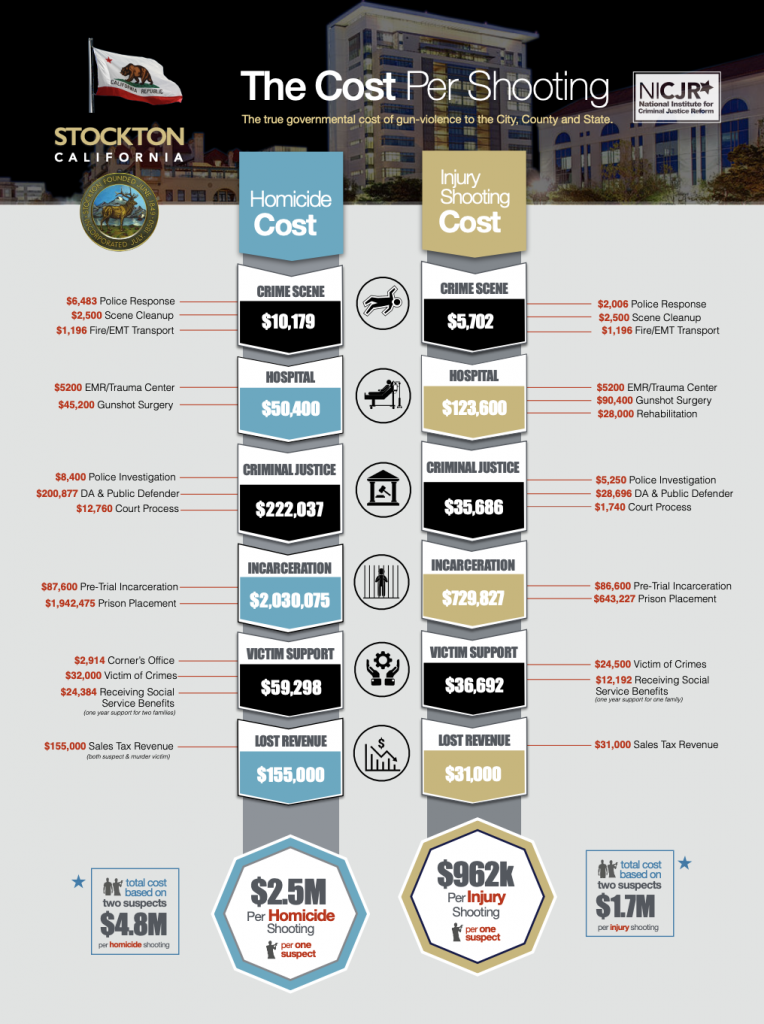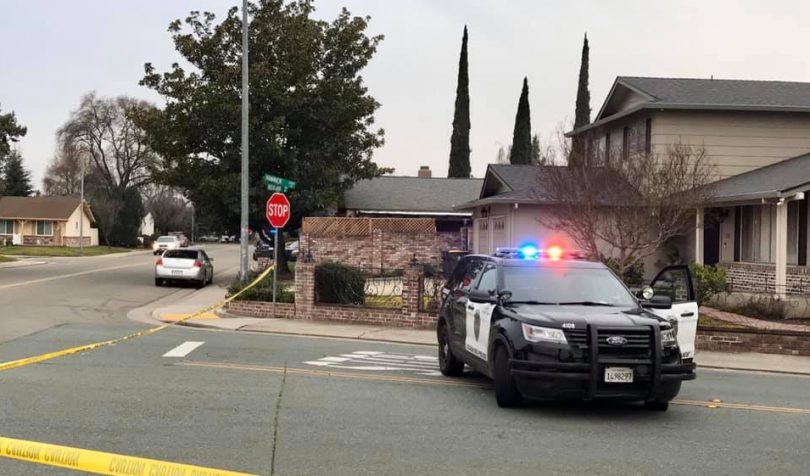A new report quantifying the cost of gun violence in Stockton, CA, estimates that each shooting homicide involving one suspect costs taxpayers $2.5 million.
This figure is likely underestimating the financial toll on the city, according to NICJR.
That price tag includes direct crime scene response (EMTs/Fire, up to 23 officers, medical transport), hospitalization, police investigation, the judicial system, pre- and post-trial incarceration, victim support and compensation, and lost tax revenue from the victim and suspected shooter.
When the number of suspects increases to two, the per homicide rate jumps to $4.8 million.
NICJR calculated that injurious (but not fatal) shootings involving one suspect cost the city approximately $962,000 each.

In recent years, Stockton Mayor Michael Tubbs and other local officials have prioritized reducing gun violence.
When Stockton Police Chief Eric Jones took the helm in 2012, the city of 300,000 experienced 71 murders — a rate higher than that of Chicago.
Since then, Jones, with the help of city and community allies, has improved homicide clearance rates and reduced the city’s once-soaring violent crime numbers, by “listening in a new way” to the communities experiencing violent crime, and by moving away from a “zero-tolerance” policing model.
In 2015 and 2016, there were 49 homicides in the city. In 2017, Stockton’s homicides increased by 6, before dropping precipitously to 33 in 2018. (Though the report doesn’t include last year’s numbers, it’s worth noting that there were 34 homicides in the city in 2019, just one more than the previous year.) Injury-only shootings also dropped from 169 in 2017 to 111 in 2018.
In 2018, Stockton’s murder clearance rate jumped to 67 percent from 41 percent in 2017.
City leaders credit the improved numbers with improving police-community relations and increasing the level of community participation in gun violence prevention strategies.
Over the last four years, Stockton experienced a total of 153 shootings that resulted in injuries or fatalities. Annually, these shootings cost approximately $250 million, according to the nonprofit National Institute for Criminal Justice Reform.
Using these estimates, the report concludes that reducing gun violence levels by an additional 20 percent could save the city $50 million each year.
The report is part of a series looking at the financial impact of gun violence across the U.S. So far, the other cities NICJR has studied are Dallas, Detroit, Mobile, Orlando, and St. Louis.
Stockton’s cost per homicide is the highest among the six, followed by Detroit’s $1.6 million-per-fatal shooting.
NICJR estimates that at the state-level, violence costs California taxpayers $1.4 billion per year. The report’s estimates do not include lost income and costs to employers, as these are not expenses passed on to the taxpayer.
The report suggests Stockton boost its modest, yet powerful, investment in violence prevention strategies and programs. “As the City experienced, relatively small investment in effective gun violence intervention strategies can yield significant reductions in shootings, save lives and produce massive savings,” says NICJR.


A couple of questions come to mind with this article. First of all, if one shooting suspect costs the city of Stockton taxpayers $2.5m, how can two suspects cost $4.8m? If I recall from my elementary school days, whenever you add decimals (i.e., 2.5 plus 2.5) you line up the decimal points, as well as the numbers in each column and then you add them up. The total should be $5.0m. Not unless this is some kind of new, fuzzy math?
Secondly, I am presuming that this article, which appears to be thrown together haphazardly while being broad in nature, is trying to sway the reader(s) that gun violence is expensive and because of this expense, that gun control should be instituted.
The article neglects to state and or categorize how these homicides transpired. Who were the suspects (i.e., gang members etc.)? What were the circumstances behind the homicide (i.e., domestic violence, gang related)? Where did these homicides occur? Maybe these insignificant details could paint a much more clearer picture?
Nonetheless, it is painfully obvious that the author of this article (Ms. Walker) has a personal, biased agenda and is looking to sway the reader(s) of this article to do away with the 2nd Amendment. If you notice when there is a shooting, especially a mass shooting, the MSM and their cronies do a cause and effect analysis. Since a person used a gun, the gun is the enemy, not the person who did the shooting.
I have my AR by the front door. The mail person delivers my mail, children going to school walk by, the neighbors gather outside to talk. By the time I get home, my AR is still where I left it. It did not jump up by itself and begin to randomly shoot and kill the aforementioned individuals. Basically, the gun is the weapon used to kill people, as would be a knife, vehicle etc. However, it is the person with the weapon who commits the actual murders.